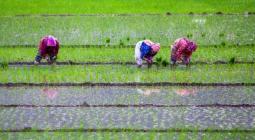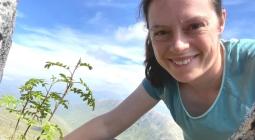Tree that lives underground among newly named plant species
Volcano-top orchid also named by scientists contending with extinctions caused by the human destruction of nature
Two types of tree and a palm that live underground are among the new plant species named in 2023 and highlighted by scientists at the Royal Botanical Garden Kew in the UK.
The palm is unique, as the only species known to flower and fruit almost exclusively underground, and was discovered in Borneo. The trees were discovered in the deep Kalahari sands of highland Angola, where the free-draining terrain has led a number of species evolving to live at least 90% underground.
Other new species include an orchid found atop a volcano, fungi from the apparently barren wastes of Antarctica and a novel fungi found in food waste in South Korea. The most mysterious new species is a plant from Mozambique that appears to be carnivorous.
There are 400,000 named plant species but scientists estimate there are another 100,000 yet to be identified. The botanists are in a race against time to discover many plants and fungi before the ongoing destruction of the natural world drives them to extinction. Lost species not only means their unique biology is gone for ever, but also potential human uses as medicines, food and even plastic recyclers.
Every year, scientists around the world name about 2,500 new species of plant and the same number of fungi. In 2023, RGB Kew researchers named 74 plants and 15 fungi species.
“It is imperative now, more so than ever, that we do everything in our power to go out into the field with our partners and work out which species of plants and fungi we haven’t given a scientific description yet,” said Dr Martin Cheek, part of RBG Kew’s Africa team. “Without doing so, we risk losing these species without ever even knowing they existed. As we make these wonderful new discoveries, we must remember that nature is under threat, and we have the power to do something about it.”
About 40% of named plant species are threatened with extinction, as habitats are razed for farmland and other human development. But as many as 75% of the world’s undescribed plant species are thought to already be threatened with extinction.
Dr Raquel Pino-Bodas, also at RBG Kew, said: “Although fungi are one of the three major groups of eukaryotes, along with plants and animals, most fungal diversity remains undiscovered. Only 5-10% percent of all existing species are known.”
She said ramping up the search for new species was critical: “Among this incredible diversity of fungal species, we are bound to discover new sources of food, medicines and other active compounds that can help us find nature-based solutions to big challenges.”
Kew mycologist Dr Paul Kirk found a new species of fungi in soya bean waste in South Korea. It is in the same genus as other fungi that thrive in elevated temperatures and can be pathogenic to humans, though this species is thought to be low risk.
“New fungal species are not only found in remote, unexplored areas, they can be found in every environment on the planet,” said Pino-Bodas.
Kew scientists Dr William Baker and Dr Benedikt Kuhnhäuser were tipped off about the underground palm by a Malaysian scientist and local communities that knew of the plant and its bright red fruit. Baker said the find showed that nature still has many surprises up its sleeve and that Indigenous knowledge is a valuable tool for the accelerated discovery of species.
The new orchid species was found fortuitously on top of an extinct volcano on the Indonesian island of Waigeo. The botanists hoped to rediscover a blue orchid that had not been seen for 80 years, which they did. But they also found a new orchid on the summit of Mount Nok, with spectacular, bright red flowers.
Antarctica is a poor place for plant hunting, with the icy continent virtually devoid of flowering plants, but it is home to many lichens. Lichens are a partnership between a fungus and algae and/or cyanobacteria. In 2023, Pino-Bodas and colleagues named three new species of fungi that grow on the lichen near the Spanish base on the Antarctic peninsula.
Another curious find was discovered in Mozambique: a plant covered in insect-trapping glandular hairs, like sundews. However, the plant was revealed to be in the genus Crepidorhopalon and therefore unrelated to any known carnivorous plant. The plant has been seen to trap insects and research is now under way to determine if the plant digests them for nutrition.
The other highlighted species named by Kew scientists are nine new species of tobacco from Australia, a Madagascan orchid, and a new violet relative from Thailand. The latter is only known from two sites, both of which are unprotected, and is therefore already considered threatened with extinction. Also threatened by farming and housing expansion is a new species of plant in South Africa that produces the dye indigo.
Cover photo: Discovered on the island of Madagascar, A bigibbum was found by Kew botanist Johan Hermans during a years-long exploration of the country’s orchids in partnership with Malagasy botanists. Photograph: Johan Hermans/RBG Kew






